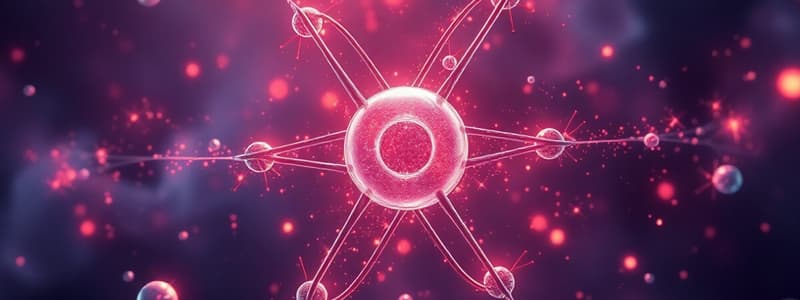Podcast
Questions and Answers
Which subatomic particle is responsible for the overall positive charge of the nucleus?
Which subatomic particle is responsible for the overall positive charge of the nucleus?
- Atoms
- Protons (correct)
- Electrons
- Neutrons
What is the approximate ratio of the mass of a proton to the mass of an electron?
What is the approximate ratio of the mass of a proton to the mass of an electron?
- 100:1
- 2000:1 (correct)
- 1000:1
- 1:1
The radius of an atom is typically measured from:
The radius of an atom is typically measured from:
- The center of the nucleus to the outermost electron shell (correct)
- The surface of the nucleus to the nearest electron shell
- The center of the nucleus to the nearest electron shell
- The surface of the nucleus to the outermost electron shell
Why do electrons orbit the nucleus?
Why do electrons orbit the nucleus?
What is the primary factor that determines the energy level of an electron?
What is the primary factor that determines the energy level of an electron?
Which of the following statements about electron shells is TRUE?
Which of the following statements about electron shells is TRUE?
Which of the following is the best analogy for the structure of an atom?
Which of the following is the best analogy for the structure of an atom?
What does the quantization of energy levels mean for electrons?
What does the quantization of energy levels mean for electrons?
In comparison to the size of the entire atom, the nucleus is:
In comparison to the size of the entire atom, the nucleus is:
What is the primary force responsible for holding the nucleus together?
What is the primary force responsible for holding the nucleus together?
Flashcards
Atom
Atom
The smallest unit of matter, made of a nucleus and electrons.
Nucleus
Nucleus
The center of an atom, containing protons and neutrons.
Proton
Proton
A positively charged subatomic particle found in the nucleus.
Neutron
Neutron
Signup and view all the flashcards
Electron
Electron
Signup and view all the flashcards
Electrostatic attraction
Electrostatic attraction
Signup and view all the flashcards
Mass of an atom
Mass of an atom
Signup and view all the flashcards
Electron shells
Electron shells
Signup and view all the flashcards
Energy levels
Energy levels
Signup and view all the flashcards
Radius of an atom
Radius of an atom
Signup and view all the flashcards
Study Notes
Structure of an Atom
- Atoms are tiny particles too small to be seen with the naked eye. They consist of even smaller particles called subatomic particles.
- Atoms are made up of a central nucleus surrounded by orbiting electrons.
- The nucleus contains protons and neutrons. Protons have a positive charge, and neutrons have no charge. This makes the nucleus overall positively charged.
- Electrons have a negative charge and orbit the nucleus due to electrostatic attraction.
- The arrangement of these particles is similar to planets orbiting the sun, with the nucleus acting like the sun and the electrons acting like the planets.
Mass and Size of an Atom
- Protons and neutrons have roughly the same mass, while electrons are significantly lighter (2,000 times lighter).
- The majority of an atom's mass is concentrated in its nucleus, containing the protons and neutrons.
- The radius of an atom is measured from the center of the nucleus to the outermost electron shell, typically around 10^-10 meters.
- The nucleus is much smaller than the entire atom, even though it contains most of the mass. It's like comparing a sports arena to a single "p" in the middle of the arena.
Electron Shells and Energy Levels
- Electrons orbit the nucleus in specific shells or orbitals, each representing a distinct energy level.
- Electrons closer to the nucleus have lower energy levels, while those farther away have higher energy levels.
- This is similar to planets orbiting the sun, but electrons can only occupy specific orbits with specific energy levels.
- The energy levels are quantized, meaning electrons can only exist at specific energy levels determined by their distance from the nucleus.
Studying That Suits You
Use AI to generate personalized quizzes and flashcards to suit your learning preferences.




